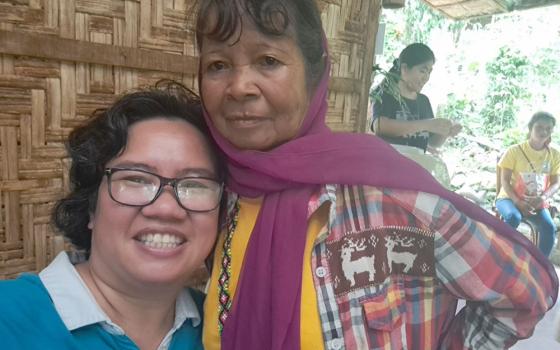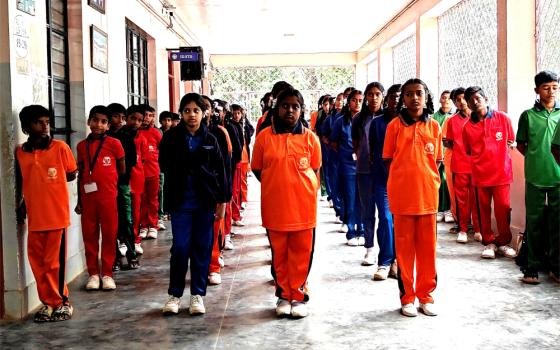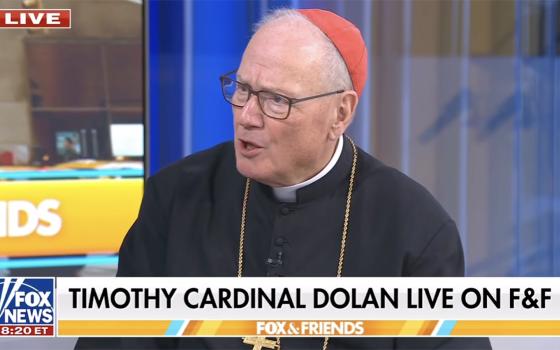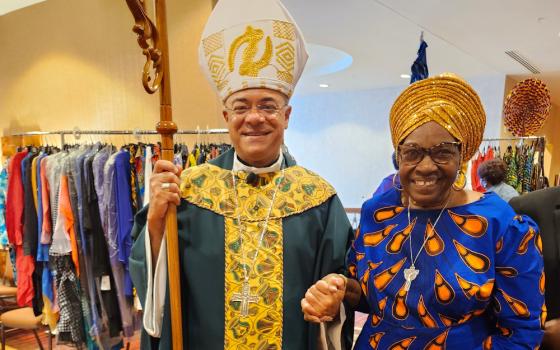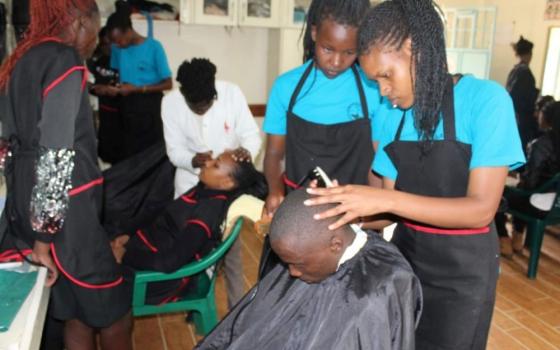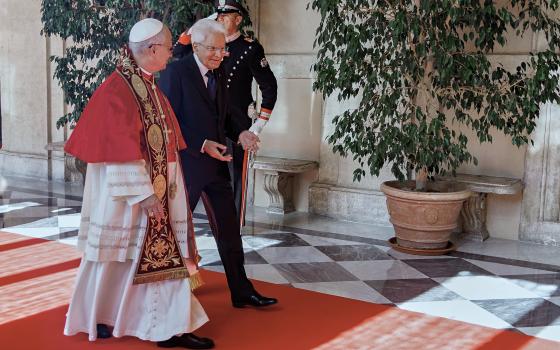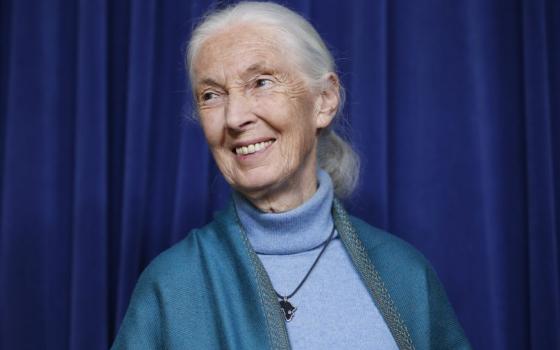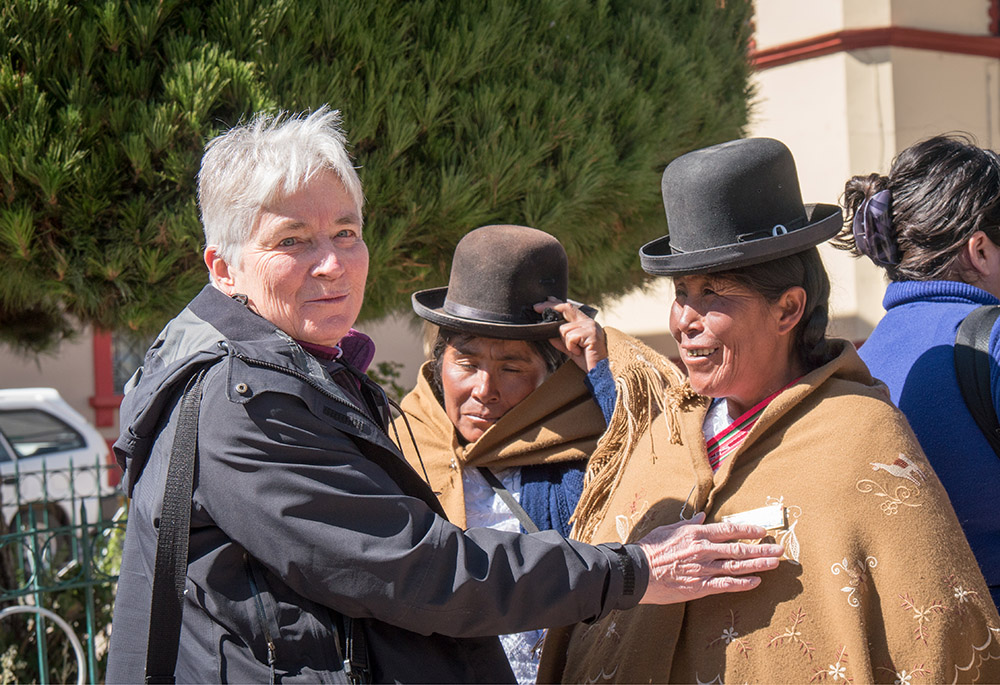
In this 2016 photo, Maryknoll Sr. Patricia Ryan speaks with Lucila Ticona Vda. de Laura and other Aymara community leaders from Chila Pucara and Chila Chambilla communities, in an Acción de Amparo ("appeal brought on grounds of violation of rights and liberties"), at Plaza de Armas, Puno City, Puno Department, Peru. (Courtesy of Maryknoll Magazine/Nile Sprague)
Editor's note: The phrase "just transition" is part of the growing lexicon about moving from an economy based on fossil fuels to clean energy. But this phrase's meaning varies. The term can also mean the need for a just transition to new jobs for those employed in industries such as mining, and for protecting the rights of those whose lands are affected by extractive industries. Catholic sisters are involved along the spectrum of transition efforts.
Few are better positioned to speak about the challenges of extractive industries and their relationship to human rights than Maryknoll Sr. Patricia Ryan.
Ryan's nearly five decades of ministry championing human rights was recently recognized with an award from the National Coordinating Committee for Human Rights, with the acronym CNDDHH in Spanish — an umbrella group of 80 nongovernmental organizations "dedicated to the education, defense and promotion of human rights in Peru."
The award is named for the late Peruvian human rights activist Mamá Angélica, a Quechua woman, and honors female human rights defenders.
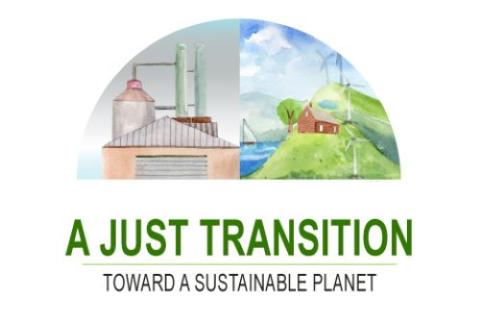
Ryan belongs to the nongovernmental ministry Derechos Humanos y Medio Ambiente (Human Rights and Environment), or DHUMA, which works in all 13 provinces of the Puno region, which includes both Aymara and Quechua Indigenous peoples.
Her ministry has focused on education but also ways "to search and implement constructive and non-violent alternatives to the situation of extreme poverty, violence and environmental destruction," as Ryan's Maryknoll biography states. Ryan and a group of Maryknollers working in the Juli Prelature of Puno were honored in 2008 with the National Award of Human Rights in Peru in recognition "of the work Maryknoll had done since 1943 among the indigenous peoples of the Altiplano." In 2018, DHUMA received another honor: the Institute for Policy Studies' international Letelier-Moffitt Human Rights Award, named after human rights activists assassinated in 1976 in Washington, under orders of the Pinochet government in Chile.
In the past year, Ryan and Indigenous community members have publicized environmental challenges at events such as the United Nations Commission on the Status of Women, or CSW. In those forums, she and her colleagues have stressed the importance of the United Nations' International Labor Organization Convention 169, which recognizes the rights of Indigenous people in possible exploitation of land.
Ryan spoke to GSR recently while she attended the Maryknoll General Assembly in Ossining, New York, and, later, after receiving the recent human rights award during a Dec. 4 ceremony in Lima, Peru. In Lima, Ryan was interviewed by Barbara Fraser, the former editor of National Catholic Reporter's EarthBeat .
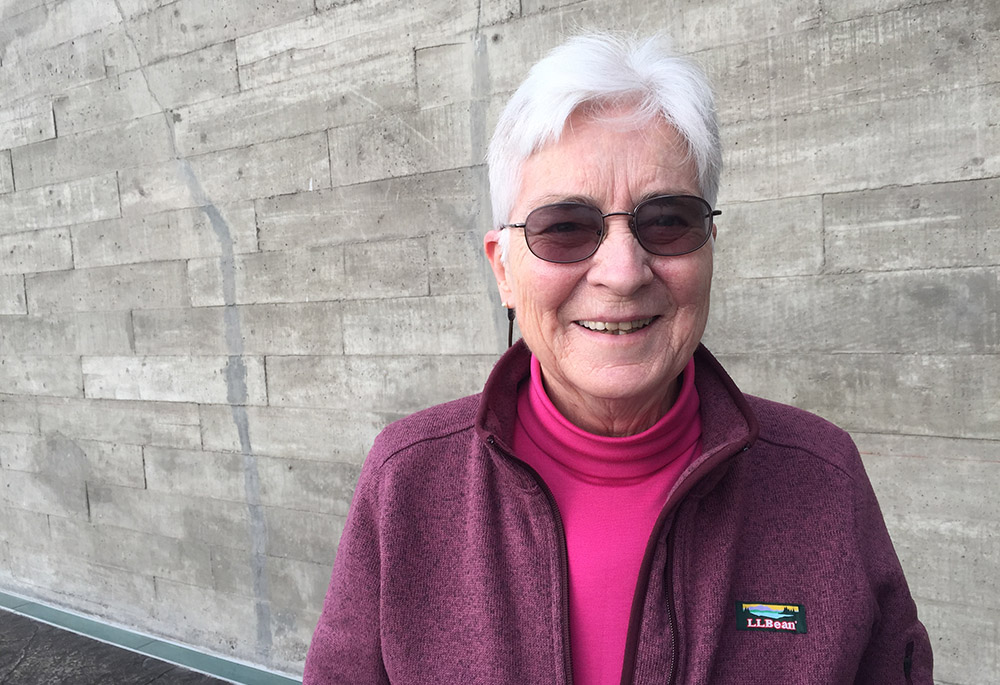
Maryknoll Sr. Patricia Ryan was honored recently with an award from the National Coordinating Committee for Human Rights, an umbrella group of 80 nongovernmental organizations "dedicated to the education, defense and promotion of human rights in Peru." (Global Sisters Report/Barbara Fraser)
GSR: What does this award mean to you?
Ryan: It is such a great honor to receive this award, especially given that it is in honor of Mamá Angélica. She has been a model to all of us in Peru for her courage and her unwavering persistence for years and years until her death in 2017 demanding an accounting for the thousands of people disappeared during the 20 years of political violence.
All that she was able to do for the cause of the mothers and other relatives of the disappeared is truly extraordinary. So to be offered this particular award has quite an impact on me. This particular award has great, great meaning and great depth to it. I am overwhelmed and tremendously honored to have received it.
What are your general thoughts about the term "just transition?"
We haven't used the term much, but some context is necessary: we had 20 years of political violence that we lived through in Peru from 1980 to 2000. Later a Truth and Reconciliation Commission formed, and they gave a report. In that report, they tried to get at some of the root causes of why this violence happen here in Peru. And why was it that the vast majority of the people killed were Indigenous people.
They concluded that one of the primary reasons was the 500 years of exclusion, discrimination and racism lived in Peru. This context made it possible for those who lived in urban areas such as the capital of Lima to ignore what was happening in rural areas where the Indigenous people were the innocent targets or fodder of both the Shining Path and the armed forces. Their lives simply did not matter; the rest of Peru did not care because "they are only Indigenous."
So, no outcry arose nor were concerted efforts made to put a stop to the violence until thousands had already been killed or disappeared in the provinces. And then another moment occurred and eyes were opened when the violence began to take a toll in urban neighborhoods better off economically in Lima.
Until discrimination, exclusion and racism are addressed, there will never be real progress or sustainable development. Perhaps in Peru that is where just transition needs to begin by addressing these major concerns, providing good quality basic services for all Peruvians and assuring equal respect for the dignity and rights and life of each Peruvian.
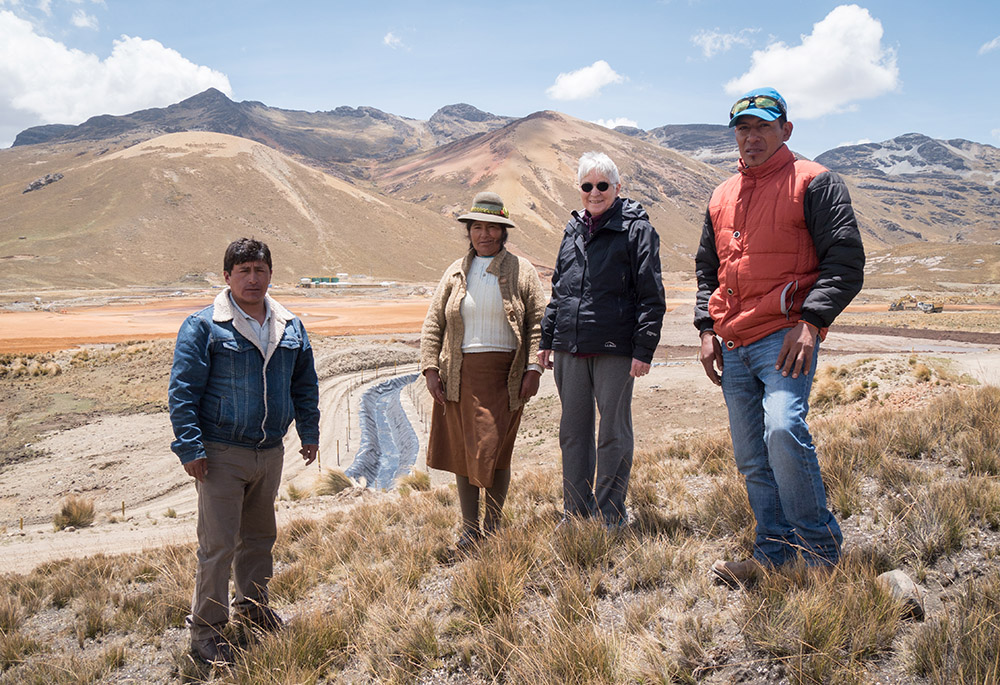
In this 2016 photo, Maryknoll Sr. Patricia Ryan, second from right, is seen with Simon Orihuela, in a blue jacket, former president of Condoraque Community; Ubaldo Layme Jile, wearing a blue cap, the president of Condoraque Community; and Feliza Quispe Apaza, wearing a brown skirt, a lieutenant ("teniente") of Condoraque Community; all above a marsh contaminated by water from a tungsten mine, at Condoraque, Puno Department, Peru. (Courtesy of Maryknoll Magazine/Nile Sprague)
How do the extractive industries play into this?
Right from the beginning, there has been total exclusion of Indigenous communities. We must keep in mind that this is their land that we are talking about, their ancestral land. In practice, there is never direct communication to the communities informing them that there is interest in having a mining claim in their territory or that a request for a mining claim has already been filed.
Thirty days go by. That is the time that people would have in order to put in an observation or a question regarding whether this should go forward or not, or to say, "Hey, wait a minute, this is our territory. We would like to say something about this. We want to be part of this consideration of giving authorization for a mining claim." In fact, the communities have no idea that a request for a mining claim had been filed and then subsequently approved without their knowledge, consultation nor authorizing consent.
Tell us about Convention 169, which recognizes the rights of Indigenous people in possible exploitation of land.
Convention 169 focuses on the rights of Indigenous people. It's a beautiful document, but I think it's one of best-kept secrets in the world. People in Peru are only just beginning to learn what the document says.
It is very important not only at an international level. Once a country ratifies Convention 169, it is on the same level or ranking as the constitution of the country. No other legal norm can be passed or implemented if it violates Convention 169. [Peru ratified it in the mid-1990s.]
However, in Puno there has never been a consultation to ascertain if a community would wish to have a mining claim in their territory. They have never been informed in the communities that there's even interest in this, nor what it would involve nor how it would impact their territory, lands, natural resources, water, livelihood, and their understanding of relationship to the earth, their "cosmo-vision." None of this is taken into account.
As you said in your presentation earlier this year, this has led to peaceful demonstrations, strikes and community efforts to publicize the plight of communities.
I consider the protests in our area to be peaceful. Certainly, people are not armed, they're just trying to have their voice heard about a major concern which affects their lives and their livelihood. They want to be listened to and to have their rights respected. They should be fully informed and an integral part of the whole process — it is their right, and this is not being respected. They are oftentimes met with violence, people are wounded or killed, arrested, jailed, brought to trial and sentenced to imprisonment.
You had at least one victory, right?
Yes, we carry multiple emblematic cases in defense of the rights of Indigenous peoples enshrined in Convention 169. One historical example that established a precedent at the national level is the case of the 11 Quechua communities of Atuncolla where the right to prior information, consultation and consent during the process of granting mining concessions in the territories of indigenous communities was upheld and enforced [in a 2016 court ruling]. That was a major win. It has also encouraged the use of the judicial process as a nonviolent tool of struggle to defend the rights of Indigenous peoples throughout the country.
Advertisement
Paint a picture of what these situations look like on the ground.
One day I was visiting some Aymara communities. They were waiting for a consultation. They had asked to meet with the mine. The mine said they would come; the communities had invited us to accompany them, so we went up there. We're waiting and waiting and the mine officials didn't come. This is at about 4,500 to 4,600 meters above sea level — the equivalent of 14,850 -15,180 feet — and it's an open plain; it's windy and freezing. And all of a sudden — you know those Brinks cars? The yellow cars that pickup money from the banks. I didn't know what one was doing up there.
I asked, "What would that be doing up here?" Someone said: "That's coming from the mine." "Oh really, what does it come for?" A woman answers: "Three of them come every other day and pick up gold from the mine and take it directly to the airport."
And then the people say, "Now, look around us. Do you see any development here?" Nothing. I saw nothing, only mountain desert barrenness.
And then, after this, they said, "Please come with us. We want to show you the river." We get to a point where you see the river; it's all contaminated. There's no doubt that it's coming from the contamination caused by the mine. Then they tell me about their cattle dying from the mine. This is their livelihood. There's not only no development brought in by this mine, but no respect for the rights of the people, no respect for Mother Earth. The mine is contaminating the water and causing death to the livestock, which is the livelihood of the communities, and causing sickness and death to the Indigenous peoples.
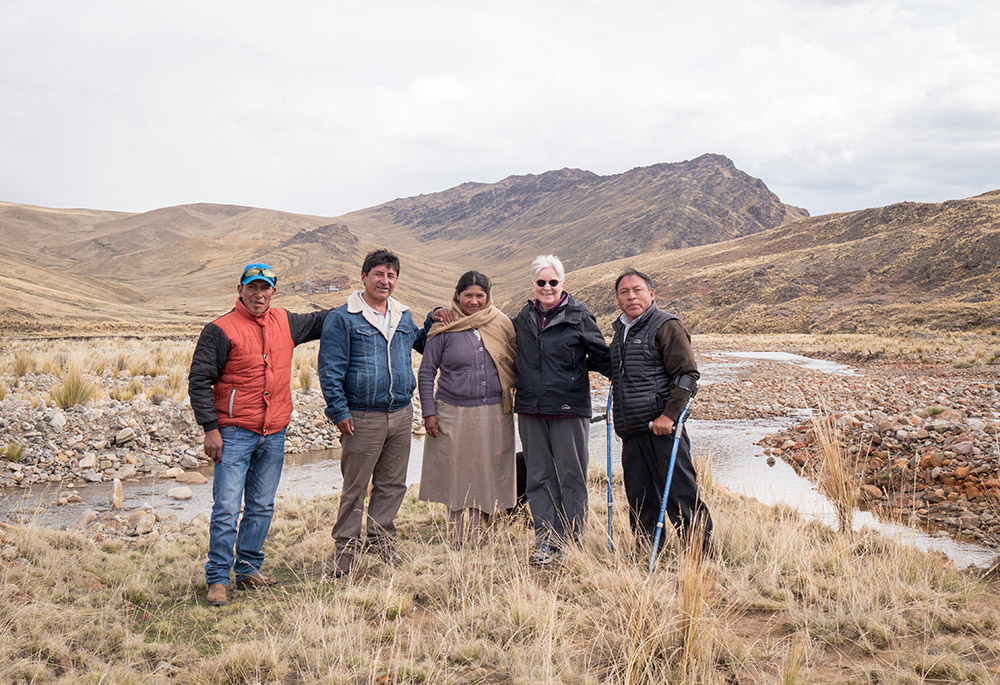
In this 2016 photo, Sr. Patricia Ryan, second from right, is seen with Cristobal Yugra Villanueva on crutches, a Derechos Humanos y Medio Ambiente lawyer; Simon Orihuela, in a blue jacket, former president of Condoraque Community; Ubaldo Layme Jile, with a blue cap, president of Condoraque Community; and an unnamed woman; in Condoraque, Puno Department, Peru. (Courtesy of Maryknoll Magazine/Nile Sprague)
How would you align these experiences with the concept of just transition?
First and foremost, Indigenous people have to have a direct, vital part in any decision that is being made regarding their territory. They have to be a part of the decision-making process right from the beginning. They have to be seated at the table and not just as equals at the table but it has to be recognized that this is their territory, and others wishing to enter for the purpose of economic activities do not have the right to affect the community's life and livelihood negatively.
The rights of Indigenous peoples must be respected as stipulated in Convention 169 and the rights of Mother Earth, especially water, must be held sacred. Any profit produced must be distributed equitably, especially in benefit of local, regional and national basic needs and any extractive activity must assure true sustainable development. Both the right of the people to benefit from their natural resources and the profit due the extractive industry should be determined justly.
Are you opposed to extractive industries in general?
I'm not necessarily against extractive industries or mining. I'm told that there is clean technology. I'd like to see it. I'd like to see that this really can be done without causing harm. If that can be done, then there are negotiations that might be able to take place with the communities. I believe that all of the communities should be benefiting from the mining taking place. People should have access to health, to water.
As you look back at all of the years that you've worked in human rights, is there something particular that stands out?
Each moment has its specialness. Certainly, the time of solidarity and the response during the 20 years of political violence was an especially demanding time. We were able to respond because we were so united as a church and we stood together with the people in the defense of life and against all forms of violence whatever its source. We worked together as one. It is something you could never have achieved alone.

